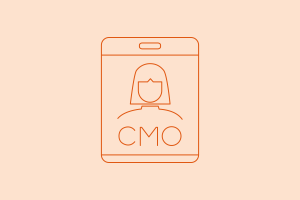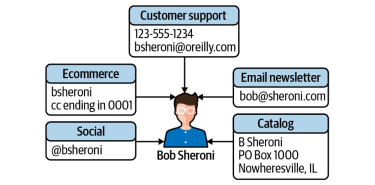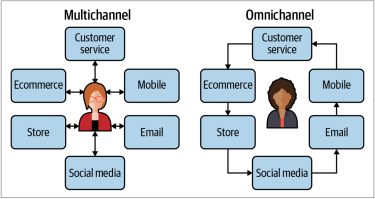A CDP Guide for CMOs

Data drives today’s greatest digital experiences, but simply having millions of customer data points means nothing if you can’t activate it. Thankfully, customer data platforms (CDPs) are helping businesses spin that data into golden customer insights. The CDP space is growing stronger every year with $2.4 billion in venture capital investments in CDPs in 2021, according to Gartner research.
In this CDP guide, we explore considerations CMOs should have when looking to get more from their customer data with a CDP investment.
Why it’s time for a CDP
Consumers are opting to shop online more than ever — the convenience and speed of digital commerce just can't be matched. Brands today must initiate and sustain meaningful relationships with consumers, catering to their unique behaviors and interests across a variety of channels. To provide a consistent customer experience, organizations must be able to integrate and act on this wealth of data. Research consultancy McKinsey reports that brands that leverage customer behavioral insights outperform peers by 85% in sales growth and more than 25% in gross margin. Siloed and unintegrated data and marketing stand in the way of providing the right messages and offers to customers at the right time.
Only when accurate data is available to everyone in an organization can you say that you’re making data-driven decisions. And the savviest businesses are turning to a CDP to serve as their company’s single source of truth. A CDP provides a 360-degree view of each customer, allowing employees from across business units to get a clear picture of their purchase history, preferences, and brand interactions.
The four elements of a CDP
Marketing technology consultant David Raab developed the concept of a CDP over a series of blog posts in 2013 and later went on to found the vendor-neutral CDP Institute, which developed the first definition of the term. By 2020, the CDP Institute identified 133 CDP vendors and estimated annual industry revenue at $1.3 billion. While still a nascent, growing marketing technology segment, there’s emerging consensus about what constitutes a CDP.
The research and advisory firm Gartner has identified four such facets that a technology must feature to function as a CDP: data collection, profile unification, segmentation, and activation.
1. Data collection
Customers engage with brands over a wide variety of devices and channels. CDPs must not only capture this data, but process and serve it quickly to account for its velocity.
2. Profile unification
A CDP must integrate this disparate data into a “golden record” or “single source of truth” for each customer based on their personally identifiable information (PII). The figure below illustrates basic task of profile unification.

Notice that, in this example, two different email addresses are provided. A CDP must be able to integrate this divergent — even possibly conflicting — customer data.
Profile unification is logistically and computationally demanding. A CDP that unifies this data based on exact matches alone risks discarding huge numbers of customer profiles. Many CDPs use sophisticated statistical models to match disparate pieces of PII based on probabilistic evidence. Identity resolution, more generally, is used to integrate identifiers from all devices, platforms, and channels to create a unified customer profile.
3. Segmentation
Customer segmentation is nothing new. The CDP serves to unify and simplify how marketers perform this segmentation. With all customer data integrated into a customer-level record, segments can be defined using information ranging from media engagement and purchase data to call center interaction data.
4. Activation
Finally, the CDP should facilitate driving customers to action through brand interaction. Done right, this goes far beyond the targeted advertisements of data management platforms (DMPs): Customers should be driven to action by an omnichannel, cross-journey experience. For example, CDP activation looks like e-commerce showing users different offerings based on their last in-store or online purchases. Or it could be call center and social media representatives using a particular script based on the identified needs of the customer’s segment.
Consumers today are looking for contextually relevant and highly personalized engagement across all touchpoints and channels. They're open to trusted brands working with their data in exchange for these experiences, so long as it's done transparently. Ultimately, the CDP offers a marked shift from “interruption marketing” to “permission marketing.”
The new challenges of marketing
Sending one-time campaigns to large segments of customers via email or other static channels was a breakthrough in the 1990s. But marketers in the 2020s are encountering new challenges and opportunities for delivering a customer-centric approach. Older marketing technologies just aren’t up to the task. These forces include: data, omnichannel marketing, customer experience, and personalization.
Increasing data volume, variety, and velocity
While the term “Big Data” to describe the explosion in data reached its apogee in the mid-2010s, there’s no question that something dramatic happened in the production and collection of data in the last 20 years. Marketers' access to customer data was no exception.
The World Economic Forum estimates that by 2025, 463 exabytes of data will be created each day globally. From email to web searches and social media posts, individual consumers create much of this content.
Accompanying this surge in data volume is an increase in variety, not just in media, but in devices. At the turn of the 20th century, just over one in two U.S. households had one desktop computer. By 2014, more than 90% of U.S. households had at least three connected devices, and not just desktop computers — from laptops and mobile phones to tablets, consumers are consuming and generating more data from more sources.
Today’s consumer-generated data moves faster than ever. Consider the always-on nature of social media versus engaging with a brand via telephone or mail. As data moves faster, it often also loses value or relevance more quickly. This is especially true for connected devices, such as the Internet of Things (IoT), that generate real-time data meant to be acted on just as quickly.
Omnichannel engagement and attribution
An omnichannel strategy is designed to offer customers a unified experience across all channels. For example, in an omnichannel approach, a customer can shop for products online, then pick them up at the store. The below figure shows the difference between multichannel and omnichannel marketing.

Earlier marketing technologies weren't designed to accommodate this growth in number and variety of devices and channels. Database marketing primarily focused on offering customers a fixed offer via email; for example, informing customers of a promotion valid online or in stores but often not both.
An omnichannel approach also facilitates marketing attribution. Consumers today go through a near-infinite variety of channels and touchpoints before making a purchase. Without an omnichannel approach, it’s nearly impossible to integrate and track how these various touchpoints lead to a conversion.
Customer-directed experiences
More broadly, the explosion in devices, data, and channels signals a freshness in how consumers interact with brands. With new technology and sources of information, consumers choose when to engage with brands and why. A fixed customer journey doesn’t conform to the changed role of brands as a source of on-demand data and information to its customers.
Personalized data and the end of cookies
Of course, to provide individualized experiences, organizations must draw from individualized data. They've relied on browser cookies for that for two decades, but it's ability to offer a truly customer-centric experience has met its limits for a few reasons.
First, cookies aren’t purely personalized but rather pseudonymous data sources. They also have limited value past the acquisition phase of the customer journey, because they're primarily used to serve targeted advertisements to segments of users. Moreover, consumers have reached a tipping point with this marketing strategy, and changes to browsers and the web itself signal a move away from the cookie’s dominance.
With the eventual demise of cookies and their ultimate failure to provide a holistic customer experience, marketers are examining how best to gather, analyze, and act on personalized data. The quest for PII presents a number of logistical and ethical challenges for organizations, including the need to keep this information safe and transparent.
Achieving a unified customer experience
A change in marketing is more than just a change in technology. A successful move to a unified customer experience takes strong cultural realignments. Consider these six recommendations to help provide more customer-centered marketing, regardless of your current data-driven marketing maturity.
1. Adopt an agile mindset
This field borrows heavily from the agile software development framework. Agile software development emphasizes collaboration between cross-functional teams and continuous product improvement and iteration. This is to be contrasted with traditional, so-called waterfall software development, where software is built and delivered in discrete stages of the lifecycle with little iteration.
While agile can be used in any implementation or project, adopting a CDP is especially suited to the practice too. Operating cross-functionally across IT, marketing, and analytics will help to deliver a unified customer experience. And while a CDP is designed to integrate any type of customer data, agile practices suggest starting small and iterating. It’s constantly maturing.
The key here is not to try to boil the ocean. Even if you start with only a few data sources, there’s still a lot of value in your CDP. You can then add data sources as you grow and evolve the program. You might think of it as a “crawl-walk-run” approach. You can use agile methods to iterate and constantly improve on delivering a unified customer experience through your processes and tools.
2. Adopt a culture of data literacy
Customer-first marketing is data-driven marketing. Individuals across the organization must be comfortable collecting, analyzing, and reporting on data to drive customer experiences. But many may be wary of these tasks: a 2020 report from consultancy Accenture and software company Qlik found that only 21% of employees report feeling confident in their data literacy skills. Establishing formalized analytics training programs and communities of practice for all roles and levels serves to promote and institutionalize data literacy in an organization. With this shared knowledge basis, cross-functional teams are better able to use data together to deliver superior customer experiences.
3. Build a culture of experimentation
As organizations advance their data-driven marketing maturity, they tend to move from monolithic, single-channel campaigns to micro-targeted, omnichannel ones. In the same spirit of agile development, leaders must be comfortable with releasing minimally viable marketing offerings into production and iterating over time given resources and needs. At the same time, a faster learning rate means a faster failure rate, so culturally the organization should be comfortable with these advantages and disadvantages of business experimentation.
4. Communicate directly with customers
When it comes to marketing campaigns, experimentation can only work with rapid and frequent feedback from customers. This feedback can be both quantitative and qualitative, in the form of customer satisfaction, product surveys, and more. User testing tools can also validate and gather early data on new features. Regardless of the instruments used, customer-first organizations must make it easy for customers to get in touch. This means making it easy to find resources such as a contact page, frequently asked questions, or a telephone number to call. Many organizations have begun to use chat or chatbot features to lower the barrier and cost of providing quick customer communication touchpoints.
5. Augment customer communication with artificial intelligence
As in the use of chatbots, being customer-centric doesn’t necessarily mean providing human interaction at every touchpoint. Artificial intelligence (AI) can be used as a frictionless medium to handle common customer service procedures or gather information about a case before passing it to a human representative. Customer experience consultancy Servion predicts that by 2025, three-quarters of customer service interactions will be driven by AI-powered tools like chatbots and voice command.
6. Emphasize retention
When an organization adopts a CDP, its marketing metrics should emphasize long-term retention over one-time conversions. This approach can be followed by any organization looking to put the customer experience first. It’s well known that retaining a customer is less expensive and more beneficial than landing a new one. Consider how you can align your marketing strategies and metrics around that truism.
How to successfully implement a CDP
Have you ever heard the expression “everyone is now a marketer?” There’s some truth to this saying, at least as it relates to CDP implementation: to be successful means aligning values and incentives across teams, from the C-suite to frontline staff. CDPs also rely on cutting-edge technologies and business processes, which often deviate from traditional practices. But no technology implementation is just about technology: it takes an alignment of people, processes, and tools. Let’s see how to ensure a successful CDP adoption and how to measure that success.
Aligning the C-suite
Traditionally, the adoption of a new marketing technology rested with IT and, of course, marketing. A CDP adoption and subsequent shift of marketing to a customer-centric approach, however, needs organization-wide recognition, which even touches the C-suite.
If a company has decided it wants to be customer-first, a CDP implementation works best if it’s a top-down directive where all stakeholders involved with customer data agree it’s important. Even leaders of areas who ultimately won’t use the CDP, such as human resources or finance, should be informed early that a CDP will be implemented and how it will be evaluated. As you’ll see, some traditional key performance indicators (KPIs) for marketing are no longer the right fit for a CDP-equipped organization, so transparency is required to make the change. The C-suite may also not just need to be aligned but augmented to successfully adopt a CDP. For example, a leader such as a chief experience officer or chief customer officer may be needed to oversee and coordinate not just the CDP but customer-centric marketing as a whole. In fact, Gartner has reported that 90% of organizations now have some C-level role equivalent to a chief experience officer or chief customer officer.
Establishing ownership: Marketing, IT, and analytics
Previous marketing technologies took advanced technical abilities such as manually writing database queries to create and extract segments. This was often performed with the support of IT by marketing researchers. By contrast, a CDP is built to lower the barrier to entry for powering data-driven marketing and personalization. So what role does IT play in the CDP as opposed to marketing?
Typically, a marketing department holds the budget for a CDP as its primary user. This is not to say that IT, as an organization’s typical standard-bearer for the collection and processing of data, does not play a part in its implementation. IT must be informed and buy into the benefits of a CDP for the same reasons as the C-suite: customer-first marketing is an organization-wide shift. Logistically, a CDP’s features, such as integration of PII and activation across channels, mean less technical intervention by IT. These tasks might have been extremely time-consuming or even impossible for the savviest engineers to conduct. Perhaps, paradoxically, it is with this burden of tedious technical work lifted that IT may be needed more than before to partner closely with marketing: to deliver a customer-first experience across the brand.
Many customer-centric organizations adopt cross-functional teams structured around the customer journey, combining resources and talent across the organization to optimize each part of that journey. These teams include not just professionals from marketing or IT, but also those from analytics and data science to help measure and monitor the team’s efforts. Organizing cross-functional teams ensures that objectives are shared across functions and that all efforts are ultimately for the sake of the customer.
Aligning frontline staff
Delivering a customer-first experience requires alignment across the organization, from the C-suite to frontline staff. Advisory firm Gallup has found that nearly 85% of employees worldwide are not engaged at work. This disengagement is especially frequent among frontline staff, who often hear about organization initiatives last or not at all; frontline software firm Yoobic found that 34% of frontline workers felt disconnected from HQ.
Frontline staff must be actively trained and encouraged to provide personalized customer experiences; their incentives must be aligned with this mission. For example, instead of seeing a customer complete a transaction online rather than in-store as a loss to their store’s earnings or commissions, frontline staff must be encouraged and rewarded for sharing this capability to interested customers.
Ultimately, this approach should be designed to benefit both the customer and the organization at large, not just a siloed individual or team staff. Use of the same data at the frontline as in the rest of the organization means a consistent delivery of experiences, a primary aim of omnichannel marketing.
Measuring CDP success
A goal of the CDP is to predict and deliver on what customers are looking for in a brand over their lifetimes, not just at the awareness stage. That means different KPIs are needed to measure a CDP’s success. Organizations have long known that retaining, upselling, and cross-selling current customers is the quickest way to increase the top line, but they may not have had effective ways to deliver on this strategy in a digital context.
CDPs give marketers a tool to do this in a way that other marketing systems have not. That makes customer lifetime value an important metric to track for the CDP-enabled organization. Related revenue-based metrics include average order value (AOV) and return on ad spend (ROAS); again, the organization is focused less on attracting the largest base of potential customers and more on helping existing ones. The real value of the CDP is not just acquisition but loyalty and retention.
An organization’s operational efficiencies should also improve with a CDP. Marketers and other customer analysts are able to spend more time analyzing and acting on the data than on processing and preparing it. When reports are accessible across your organization, or even sent automatically, you can do a lot of things much more quickly.
Bringing it all together
Interacting with customers in the way they want to be interacted with is a delicate dance. It takes consideration, patience, and data to get it right. A customer data platform can help channel that data into meaningful insights that your team can use to build stronger customer experiences for your audience.
Learn more about making CDP a part of your marketing technology (martech) stack in our free e-book, A Chief Marketing Officer’s Guide to CDPs.

